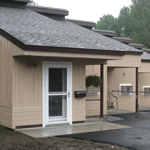
More than 200 historic windows were replaced at the former Hotel Barre to increase efficiency and offer residents fresh air. Today, the 100-year-old building houses the BHA’s Washington Apartments.
Vermont is a picturesque state, full of lush green fields, robust forests, crisp air, and crystal blue waters. It is the place to get away from the hustle, bustle, and pollution of the big city. But Vermont does find its environmental challenges—in its man-made features that get out-of-date and need upgrades.
Barre, Vermont, is a unique place. It includes a city with a population of 9,000 and a town with a population of 7,000. (The town actually encircles the city.) Setup aside, Barre is leading the way in many green practices regarding building improvements. The Barre Housing Authority (BHA) has been working feverishly throughout the past few years to improve energy efficiency and bring its outdated senior-housing residences up to the environmental standards one would expect in such a green state.
The BHA made improvements to the 15-unit Avery Apartments by installing highly efficient insulation around the building, putting on a new roof, replacing old windows and lighting, and installing Energy Star-rated air conditioning units. The parking lot was rebuilt with new storm drains, which reduce rainwater runoff and land erosion.
Additional energy-efficiency upgrades were conducted at the Washington Apartments, a 49-unit, five-story high-rise. The BHA rebuilt both the main and annex roofs to better hold snow loads after super-insulating the building and replacing more than 200 windows. “The building is more than 100 years old, so we had to work with the state historic preservation office every step of the way,” says Chip Castle, the executive director of the BHA.
The preservation office allowed the BHA to replace the windows with more energy-efficient, aluminum-clad windows. “Now everyone can open them where they couldn’t before, and they look nice and neat,” he says, “They have a historic 1900s look to them.”
In exchange for the upgrade, BHA agreed to refinish and restore eight large lobby windows, remove rot and decay from the building’s fascia, and install two faux front entrances for look and appeal. Those replacements made the building reminiscent of its former self. “It looks like it did when it was the old Barre Hotel in the 1800s,” Castle says. “This kept us in compliance with restoring a historic building and also has made our residents of the Washington Apartments much more comfortable over the long Vermont winter.”
The Washington Apartments also received a lighting upgrade that resulted in savings of 15,000 kilowatt-hours annually. That number comes from the Vermont Energy Investment Corporation (VEIC), a nonprofit organization dedicated to reducing the economic and environmental costs of energy consumption through efficiency and renewable technologies. In addition to electricity reductions, all of these efforts combined will contribute to substantially reducing the property’s oil use.
At North Barre Manor, an 11-story, 120-unit high-rise, grant funds from the American Recovery and Reinvestment Act were used to do a similar refurbishment on the windows, change out all lighting to efficient bulbs, and put in a new HVAC system. “The architect determined that the windows were in good shape and recommended resealing them rather than replacing them,” Castle says, noting that this approach also means less waste for the landfill. On the outside, large white panels that act as insulators below every window were replaced with new panels.”
Here, too, the VEIC reports substantial annual savings, to the tune of 228,000 kilowatt-hours a year, thanks to a lighting retrofit and a new HVAC system, which includes air-conditioning, a new rooftop-ventilation system, and more energy-efficient fans in every apartment.
Efficiency Vermont, a nonprofit that helps Vermonters reduce energy costs, also has facilitated large-scale direct installation of compact fluorescent light bulbs for the tenant fixtures at several BHA buildings. “In the affordable housing community, the higher cost of CFLs can be a real barrier to installation, so tenant lamps often have incandescent bulbs,” explains Colleen Scarola, an energy consultant at Efficiency Vermont.
Several projects are on the horizon, such as window and roof replacements at Green Acres, a 49-unit development, and will be rolled out as budgets permit.

